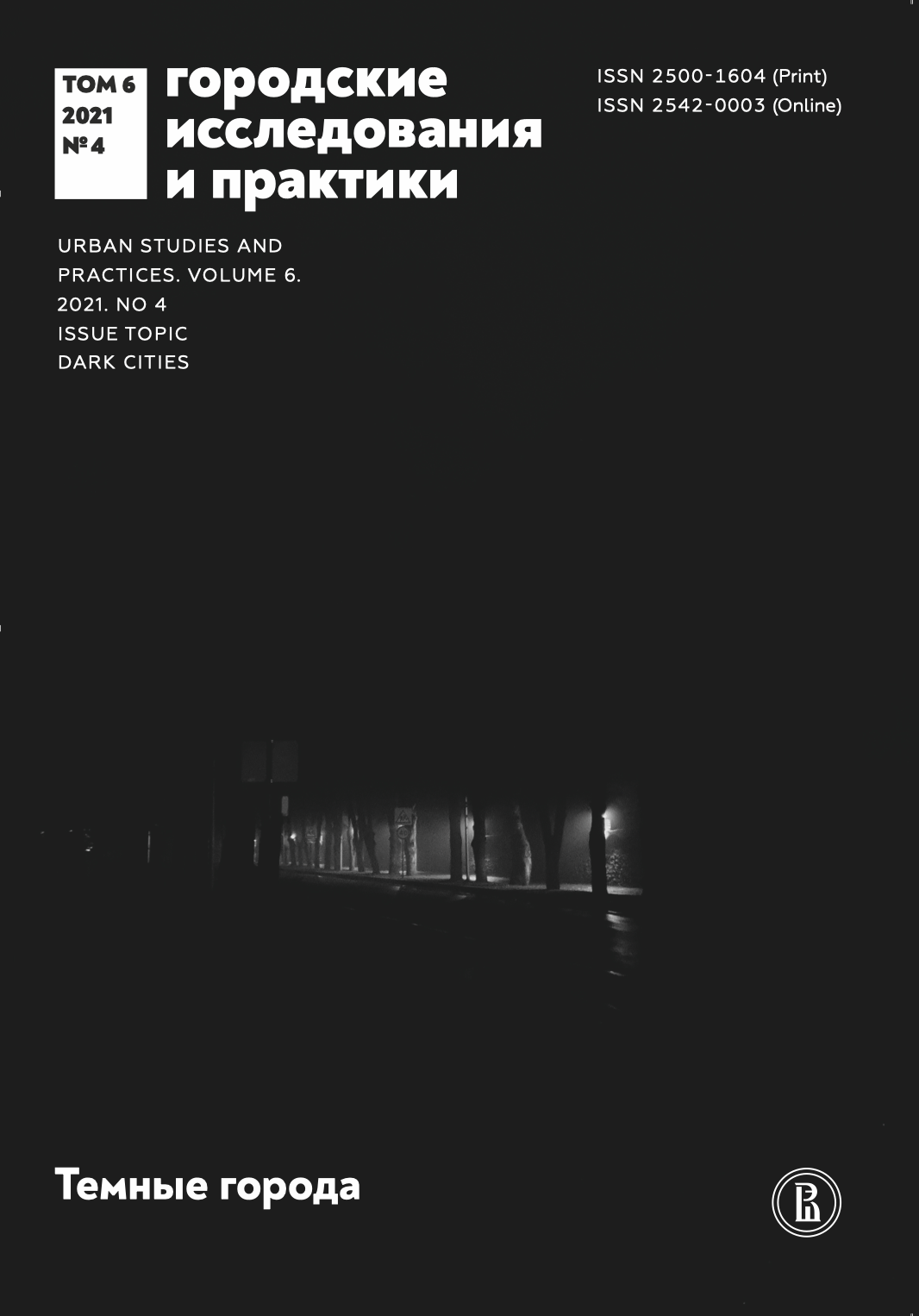«Темные города» Хулио Кортасара: от литературы к городским исследованиям
Аннотация
В статье обсуждается феномен города в художественной литературе. Цель автора — показать релевантность художественных текстов для городских исследований. Начиная с модернизма (1900-е годы), граница между фикциональностью (художественным вымыслом) и документалистикой нивелируется: автор стал хроникером, регистрирующим события без идеологической оценки. В тексте приводится обзор концепций, охватывающих город и литературу, от «протоурбанистов» (Беньямин, Дебор, Зиммель) до современных междисциплинарных подходов (городские культурные исследования, литературная и психогеография, эконарратология). В центре внимания оказывается концепция темной экологии современного философа Тимоти Мортона. В темной экологии формулируется ранее не исследованная проблема: что происходит в пространстве без наблюдателя, то есть когда часть пространства остается в тени взгляда наблюдателя? В качестве модели для изучения этой проблематики в художественных текстах апробируется термин «темный город». Автор анализирует городские фрагменты в трех рассказах писателя-постмодерниста Хулио Кортасара, произведения которого относят к движению ситуационистов (художественная урбанистическая проза первой половины XX века). Рассказ «Записи в блокноте» тематизирует теневую сторону метрополитена. Создается образ метро как параллельного мира внутри города, что может быть прочитано как фантастический мир внутри мира действительности (фантастический жанр) или как манифестация теневой функции инфраструктуры. Рассказ «Граффити» иллюстрирует городскую субкультуру и через нее — городскую политику и коммуникацию. Фигура граффитиста выявляет потенциал очевидца «темной» повседневности в практиках визуализации (граффити) и вербализации (нарратив) коммуникации в городе. В рассказе «Газетные заметки» фиксируются пространства «дневного города» и «ночного города», различающиеся по влиянию на сюжет. Темнота стимулирует развитие своей непредсказуемостью и инаковостью, так что ночная прогулка по городу превращается в преступление. В заключение статьи предлагаются пути дальнейшего применения подхода темного города в малоизученных областях городских исследований: субкультурах, фольклоре и аффектах.
Скачивания
Литература
Бахтин М. (1975) Формы времени и хронотопа в романе: Очерки по исторической поэтике // Бахтин М. Вопросы литературы и эстетики. М.: Художественная литература. С. 234-407.
Беньямин В. (1996) Париж, столица XIX столетия // Произведение искусства в эпоху его технической воспроизводимости. Избранные эссе. М.: Медиум. С. 142-163.
Беньямин В. (2012) Краткая история фотографии // Учение о подобии. Медиаэстетические произведения. М.: РГГУ. С. 129-130.
Дебор Г. (1999) Общество спектакля. М.: Логос.
Кортасар Х. (2001) Беседы с Эвелин Пикон Гарфилд. Фрагменты книги // Иностранная литература. № 6. С. 177-203.
Кортасар Х. (2010) Мы так любим Гленду. М.: АСТ.
Лессинг Г. (1953) Лаокоон, или О границах живописи и поэзии // Лессинг Г. Избранные произведения. М.: Художественная литература. С. 385-516.
Лефевр А. (2015) Производство пространства. М.: Strelka Press.
Фуко М. (2011) Безопасность, территория, население. Курс лекций, прочитанных в Коллеж де Франс в 1977-1978 учебном году. СПб.: Наука.
Ханова П. (2019) Тёмные города: тёмная экология и Urban Studies // Логос. № 5 (132). С. 71-86.
Anderson V. (2013) Unfrozen Music: Disrupted Synaesthesia in Julio Cortázar's Paris // Hispanic Journal. No. 1 (34). P. 115-129.
Garrard G. (ed.) (2014) The Oxford Handbook of Ecocriticism. Oxford: Oxford University Press.
Genette G. (1982) Palimpsestes: La Littérature au Second Degré. Paris: Éditions du Seuil.
Harvey D. (2003) Paris, Capital of Modernity. London: Routledge.
Herman D. (2001) Spatial Reference in Narrative Domains // Interdisciplinary Journal for the Study of Discourse. No. 21 (4). P. 515-541.
James E., Morel E. (eds.) (2020) Environment and Narrative: New Directions in Econarratology. Columbus: Ohio State University Press.
Juan-Navarro S. (2000) Archival Reflections: Postmodern Fiction of the Americas (Self-Reflexivity, Historical Revisionism, Utopia). Lewisburg, PA: Bucknell University Press.
Kaufmann V. (2006) Guy Debord: Revolution in the Service of Poetry. Minneapolis: University of Minnesota Press.
Larkin B. (2013) The Politics and Poetics of Infrastructure // Annual Review of Anthropology. No. 42 (1). P. 327-343.
McCracken E.-M. (1977) The Mass Media and Latin American New Novel: Vicente Leñero and Julio Cortázar. University of California, San Diego.
Moretti F. (1998) Atlas of the European Novel, 1800-1900. London, New York: Verso.
Moretti F. (2005) Graphs, Maps, Trees: Abstract Models for a Literary History. London, New York: Verso.
Morton T. (2016) Dark Ecology: For a Logic of Future Coexistance. New York: Columbia University Press.
Orloff C. (2013) The Representation of the Political in Selected Writings of Julio Cortázar. Boydell & Brewer Press.
Ortega T. (2016) Oesterheld y Cortázar: primer y último round por la revolución // Tebeosfera. Режим доступа: https://www.tebeosfera.com/documents/oesterheld_y_cortazar_primer_y_ultimo_round_por_la_revolucion.html (дата обращения: 04.11.2021).
Pakier M., Wawrzyniak J. (2015) Introduction: Memory and Change in Eastern Europe: How Special? // Memory and Change in Europe: Eastern Perspectives. Studies in Contemporary European History. No. 16. P. 1-22. Berghahn Books.
Potter R. (2012) Modernism Literature. Edinburgh University Press.
Ryan M.-L. (2016) Narrating Space/Spatializing Narrative: Where Narrative Theory and Geography Meet. With Kenneth Foote and Maoz Azaryahu. Columbus: Ohio State University Press.
Saunders A. (2010) Literary Geography: Reforging the Connections // Progress in Human Geography. No. 34 (4). P. 436-452.
Tambling J. (ed.) (2016) Prologue: City-Theory and Writing, in Paris and Chicago: Space, Gender, Ethnicity // The Palgrave Handbook of Literature and the City. UK: Palgrave Macmillan. P. 1-22.
Tally R.T. (2012) Spatiality (The New Critical Idiom). London: Routledge.
Tally R.T. (2018) Topophrenia: Place, Narrative, and the Spatial Imagination (The Spatial Humanities). Bloomington: Indiana University Press.
Westphal B. (2011) Geocriticism: Real and Fictional Spaces. New York: Palgrave Macmillan.

